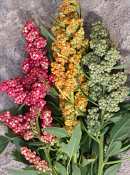Abstract: Quinoa (Chenopodium quinoa Willd.) in Chile represents a source of germplasm with high nutritional value. However, there is little information available related to quinoa seed quality grown under contrasting environments. In this study we evaluated the changes on seed composition of seeds of two lowland/coastal quinoa genotypes grown under arid (Vicuña) and cold-temperate (Temuco) conditions in Chile. Results showed that in the case of ‘Regalona Baer’ and ‘Villarrica’ genotypes the arid location (with irrigation) led to a significant increase (P < 0.05) in grain yield (4.2 and 5.1 t ha-1, respectively), soluble dietary fiber (16.8 ± 0.4 and 28.9 ± 2.1 g kg-1 DM, respectively), vitamin B3 (2.44 ± 0.005 and 2.26 ± 0.04 mg 100 g-1 DM, respectively), saponins (3.22 ± 0.38 mg 100 g-1 DM, ‘Regalona Baer’), phenolic compounds (19.2 ± 5.48 and 31.92 ± 1.14 mg gallic acid 100 g-1, respectively) and components of proximate analysis, except protein content. The cold-temperate climate (rainfed) affected positively seed size (2.22 ± 0.17 mm ‘Villarrica’) and 1000 seed weight (3.08 ± 0.08 and 3.29 ± 0.08 g, respectively), as well as insoluble dietary fiber content (112.3 ± 23.8 g kg-1 DM, ‘Regalona Baer’). Furthermore, vitamin C was higher in ‘Regalona Baer’ genotype at arid locality (31.22 ± 4.2 mg 100 g-1 DM), but much higher content was registered in ‘Villarrica’ genotype at cold-temperate climate (49.3 ± 5.36 mg 100 g-1 DM). The environment-induced relationship among variables and genotypes was consistent with principal component analysis (PCA). The arid region of Vicuña in Chile represents a potential area for quinoa cultivation for lowland/coastal quinoa genotypes, whose nutritional and functional features were affected positively, due to the much more stressing climatic conditions.
Reference:
Miranda M., Vega-Gálvez A., Martinez E.A., Lópeza J., Marín R., Aranda M. and Fuentes F. (2013) Influence of contrasting environment on seed composition of two quinoa genotypes: nutritional and functional properties. Chilean Journal of Agricultural Research. 73(2): 108-116. DOI: 10.4067/S0718-58392013000200004
Miranda M., Vega-Gálvez A., Martinez E.A., Lópeza J., Marín R., Aranda M. and Fuentes F. (2013) Influence of contrasting environment on seed composition of two quinoa genotypes: nutritional and functional properties. Chilean Journal of Agricultural Research. 73(2): 108-116. DOI: 10.4067/S0718-58392013000200004

No comments:
Post a Comment